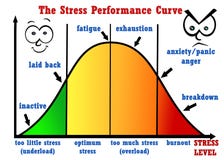STRESS CULTURE

There are 2 main
types of stress the body undertakes.
Every little thing
you do PHYSICALLY stresses the body in some way. Walking to the letterbox
induces little stress so it requires little time and resources to recovery
from.
Going for a 5km run induces a moderate amount of stress in most cases, and
requires some time and (energy) resources, to recover from.
An interval sprint training
session with short to moderate rest will induce huge amounts of fatigue and
will take plenty of time (48 – 72hrs) and resources to recover from.
We have
fallen into a fatigue based training model these days with Crossfit-type
training facilities opening up on every corner.
Fatigue is required to make
progress but only as much fatigue as you can recover from.
Every time a
decision has to be made, it can induce MENTAL stress.
Like physical stress, the
level of decision, or the consequences of that decision if it isn’t the
right one, can affect your mind and body on different levels.
These days work is akin to the fatigue model
of training above – it’s all about how much work you can complete and how many
hours you can put it and it’s actually frowned upon to not think like that.
So if you’re
putting in 80hrs of work a week, making huge decisions with huge implications
and following a high fatigue model of training to boot, then your stress level
will be ridonckulous!
The “immediateness” age we live in, with instant
connection and access to information and people around the world, means we never really
have time to rest and recuperate like the old days.
The body doesn’t
really recognise what type of stress you’re under (mental or physical), but it
does tale a lot of notice of the amount of stress you're under.
Once your stress
cup fills up then something has to give and the more stress you keep adding
without recuperation, the further away you move from homeostasis which is your
“personal baseline.”
The brain perceives
this high stress as a threat to the body and thus puts some interventions in to
try and conserve energy, such as shutting off muscle groups and altering posture
to make locomotion more energy efficient.
It also activates your sympathetic
nervous system which is the fight side of your fight or flight mechanism.
The
sympathetic nervous system gets activates in times of stress by increasing
alertness, heart/breathing rate etc.
So if your resting
heart rate is 50 beats per minute and your blood pressure is 120/70 at rest,
then in times of stress you might be starting your day at 55 beats per minute
and a blood pressure reading of 125/75, so your starting point is slightly
higher which leaves you with less wiggle room when you do not recuperate.
This all leaves you
working much harder then you should be for daily tasks using less than stellar
posture and movement efficiency, which can result in pain, injury and the
dreaded “threw my back out picking up a pencil” syndrome.
Stress pretty much
is the root of all evil and it’s not that you shouldn’t induce stress, but once
you do then you need recuperate from it before adding more stress into your cup.
The biggest issue
with this is that stress negatively effects immunity and once you’re sick then
everything listed above is amplified.
Everything you do requires more
energy to complete, pain spots re-emerge from nowhere, this induces more stress and again you’re pushed further away
from your homeostasis point.
Coming Up: Part 3 - Central Nervous System
No comments :
Post a Comment